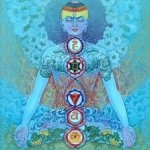|
||||
|
|
|||
Author Archives: admin
Swadhisthana chakra
Swadhisthana
|
|
Welcome to the second edition of our Kundalini yoga practice. The second chakra we explored was the Swadhisthana chakra, sacral chakra, or chakra of creativity. Literally swadhisthana means ‘one’s own abode’ and its location in the body is only 2 cm above the Mooladhara chakra, between the coccyx and the pubic bone. Therefore the asanas we practiced to balance this chakra were fairly similar to those relating to Mooladhara. After a month into this Kundalini practice we should all feel quite loose, yet strong in the hip and lower belly area.I have enjoyed exploring the new mudras associated with the chakras, as well as finding specific music that balances each chakra separately. The Tibetan crystal singing bowls track seems to be the general favourite.At the end of Yoga Nidra we played around with different visualizations. An easy visualization is that of colour and a more challenging is that of a symbolic landscape, like the ocean by night with a crescent moon, which belongs to swadhisthana chakra. In stead of the ‘so hum‘ mantra of our standard practice, we are now using the sound mantra belonging to each chakra. All these subtle changes have definitely added another dimension.Soon the next newsletter about Manipura will arrive in your Inbox, as we have already move up to the heart chakra this week.May the benefits of your practice stay with you and extend beyond you.Namaste,
Ernestine |
| Swadhisthana in a nutshell Element: Water Sound: Vam Colour: Orange Emotion: power, lust, joy, blame and guilt. Balanced: One can go with the flow and is open to new experiences. Creativity rules. Unbalanced: sexual addiction, wanting constant entertainment(overactive) or lethargic, depressed anxious(underactive) Asana: Opening the hips and strengthening the lower abdomen. 1. Mal  asana asana
3. Crescent Moon
Mudra:Yoni Mudra
 |
Kundalini Yoga – Mooladhara chakra
|
Element: Earth When Balanced: We can have feelings of anxiety, greed, fear and/or a sense we don’t belong or are not good enough. Asana: Grounding practice with standing poses.
|
||



 Leg rotations
Leg rotations








 Virabhadrasana 1,2,3
Virabhadrasana 1,2,3